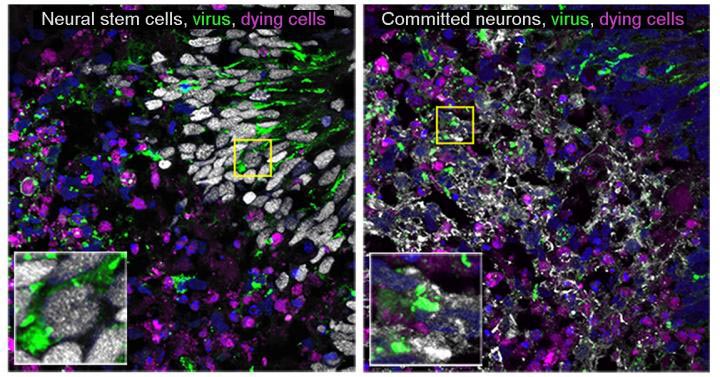Cerebral organoid model provides clues about how to prevent virus-induced brain cell death

These images taken from LACV-infected cerebral organoids show infected cells (green) and cells that are dying from infection (magenta). The left image also shows neural stem cells (white) that have the potential to become neurons; these cells are rarely dying. In contrast, the image on the right shows committed neurons (white), many of which are shown to be dying. Credit: NIAID
LACV is spread by mosquitoes and was first identified in the early 1960s. Most infections in people are mild but the virus sometimes–particularly in children–enters the brain, infects neurons and causes disease ranging from learning and memory difficulties to paralysis, seizures and death. The Centers for Disease Control and Prevention receives reports of an average of 68 LACV encephalitis cases each year in the United States, nearly all east of the Mississippi River.
The NIH scientists, from the National Institute of Allergy and Infectious Diseases Rocky Mountain Laboratories in Hamilton, Montana, used cerebral organoids to model how LACV infects the human brain. Cerebral organoids are small spheres of human brain cells ranging in size from that of a poppy seed to a small pea. Importantly, cerebral organoids contain different neuronal cell types, which allowed the investigators to assess the sensitivity of neural stem cells and neurons to LACV infection.
After infecting cerebral organoids with LACV, the researchers observed that the virus was more likely to kill neurons, and they also found that the immune response to the virus was weaker in those cells than in neural stem cells. The largest observed difference was in genes activated by interferon, which are important in protecting cells from viruses.
The investigators then repeated the experiment, but this time treated the cerebral organoids with interferon 24 hours after infecting them. The therapy successfully protected neurons from virus-induced death. The scientists plan to continue developing their cerebral organoid model and studying the feasibility of using interferon to treat LACV infection and other viral diseases of the brain.
###
ARTICLE:
C Winkler et al. Neuronal maturation reduces the type I IFN response to orthobunyavirus infection and leads to increased apoptosis of human neurons. Journal of Neuroinflammation DOI: 10.1186/s12974-019-1614-1 (2019).
WHO:
Karin E. Peterson, Ph.D., and Clayton Winkler, Ph.D., neuroimmunology investigators in NIAID's Laboratory of Persistent Viral Diseases, are available to comment on this study.
CONTACT:
To schedule interviews, please contact Ken Pekoc, (301) 402-1663, kpekoc@niaid.nih.gov.
NIAID conducts and supports research–at NIH, throughout the United States, and worldwide–to study the causes of infectious and immune-mediated diseases, and to develop better means of preventing, diagnosing and treating these illnesses. News releases, fact sheets and other NIAID-related materials are available on the NIAID website.
About the National Institutes of Health (NIH): NIH, the nation's medical research agency, includes 27 Institutes and Centers and is a component of the U.S. Department of Health and Human Services. NIH is the primary federal agency conducting and supporting basic, clinical, and translational medical research, and is investigating the causes, treatments, and cures for both common and rare diseases. For more information about NIH and its programs, visit http://www.
NIH…Turning Discovery Into Health®
Media Contact
All latest news from the category: Life Sciences and Chemistry
Articles and reports from the Life Sciences and chemistry area deal with applied and basic research into modern biology, chemistry and human medicine.
Valuable information can be found on a range of life sciences fields including bacteriology, biochemistry, bionics, bioinformatics, biophysics, biotechnology, genetics, geobotany, human biology, marine biology, microbiology, molecular biology, cellular biology, zoology, bioinorganic chemistry, microchemistry and environmental chemistry.
Newest articles

Properties of new materials for microchips
… can now be measured well. Reseachers of Delft University of Technology demonstrated measuring performance properties of ultrathin silicon membranes. Making ever smaller and more powerful chips requires new ultrathin…

Floating solar’s potential
… to support sustainable development by addressing climate, water, and energy goals holistically. A new study published this week in Nature Energy raises the potential for floating solar photovoltaics (FPV)…

Skyrmions move at record speeds
… a step towards the computing of the future. An international research team led by scientists from the CNRS1 has discovered that the magnetic nanobubbles2 known as skyrmions can be…





















